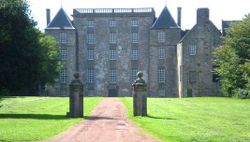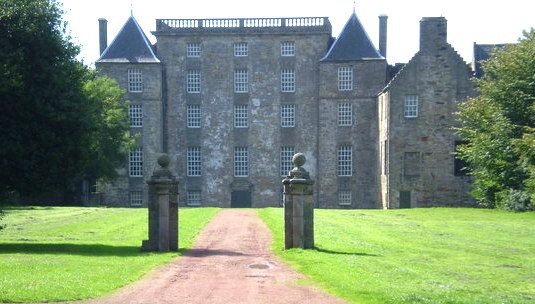He was the only son of James Hamilton, 1st Lord Hamilton, and his wife, Mary Stewart, Countess of Arran. Mary was a daughter of King James II of Scotland and his Queen consort Mary of Guelders, and was a sister of King James III of Scotland.
Hamilton succeeded to his father's lordship and inherited his lands when his father died in 1479.[1] In 1489 his first cousin King James IV made him Sheriff of Lanark, a position his father had previously had,[1] and a Scottish Privy Counsellor.[2] By 28 April 1490 he was married to Elizabeth Home, daughter of Alexander Home, 2nd Lord Home.[1]
Between April and August 1502, he commanded a naval fleet sent to help King Hans of Denmark, James IV's uncle, defeat a Swedish rebellion.[1] He negotiated James's marriage to Margaret Tudor and was present at the wedding on 8 August 1503. On the same day Lord Hamilton was created Earl of Arran, with the formal grant three days later, "for his nearness of blood" and his services at the time of the marriage.[1] He was appointed Lieutenant General of Scotland and in May 1504 commanded a naval expedition to suppress an uprising in the Western Isles.[1]
In September 1507, James IV sent Hamilton as his ambassador on a diplomatic mission to the court of Louis XII of France. When returning in early 1508, he was briefly detained in the Kingdom of England by Henry VII, who was suspicious of a renewal of the Auld Alliance between Scotland and France.[1]
When Henry VIII of England joined the War of the League of Cambrai by invading France in 1513, Scotland came under pressure to support France against England. Hamilton was given command of the Scottish naval fleet. He first sailed to Ulster and attacked Carrickfergus, the main English stronghold there. The fleet then sailed to France, arriving there in September 1513, too late to be much help as the Scottish army had been defeated at the Battle of Flodden Field in England on 9 September,[1] with James IV being killed in battle.
During the minority of King James V he opposed Archibald Douglas, 6th Earl of Angus and the English party. He plotted against the Regent John Stewart, 2nd Duke of Albany. He was president of the council of regency during Albany's absence in France from 1517 to 1520.
He was defeated in an attempt to overpower Angus in the streets of Edinburgh in 1520, a riot known as "Cleanse the Causeway". He was again a member of the council of regency in 1522 and Lieutenant of the South. He joined the Queen Dowager Margaret Tudor in ousting Albany and proclaiming James V in 1524.
Hamilton was compelled by Henry VIII of England to readmit Angus to the council. He supported Angus against John Stewart, 3rd Earl of Lennox in 1526 at the Battle of Linlithgow Bridge, but on the escape of James V from the Douglases, Hamilton received Bothwell from Angus's forfeited estates.
James Hamilton at age 15, married Elizabeth Home, the 13-year-old widow of Thomas Home of Hoprew. But it was later discovered that Thomas Hay was actually still alive so James was given a divorce in 1504 and again in 1510. James became a privy counsellor to James IV, and helped to arrange his marriage to Princess Margaret Tudor of England. As a reward he was created Earl of Arran in 1503. The earl's second marriage to Janet Beaton produced his heir James Hamilton, 2nd Earl of Arran.
Bio by Melissa Gibson (Her 15th Gen. Grandfather):
James Hamilton, earl of Arran, wrote his will on 26 March 1529, making his eldest natural son, Sir James Hamilton of Finnart, his executor and the tutor for his heir (who was still a minor). He died shortly thereafter, certainly by 31 March when Finnart was granted wardship of the earldom, and was buried at the collegiate church at Hamilton in Lanarkshire.
The old parish church of Hamilton founded by David I in the 13th century, was rebuilt in 1450, and continued in use until 1732, when it was superseded by the present church. Part of the old church remained for a long time, however, for it served as the burial vault of the Hamiltons until it was removed in 1852.
Hamilton Civic Soc 1932
Reference:https://www.wikitree.com/wiki/Hamilton-1215
He was the only son of James Hamilton, 1st Lord Hamilton, and his wife, Mary Stewart, Countess of Arran. Mary was a daughter of King James II of Scotland and his Queen consort Mary of Guelders, and was a sister of King James III of Scotland.
Hamilton succeeded to his father's lordship and inherited his lands when his father died in 1479.[1] In 1489 his first cousin King James IV made him Sheriff of Lanark, a position his father had previously had,[1] and a Scottish Privy Counsellor.[2] By 28 April 1490 he was married to Elizabeth Home, daughter of Alexander Home, 2nd Lord Home.[1]
Between April and August 1502, he commanded a naval fleet sent to help King Hans of Denmark, James IV's uncle, defeat a Swedish rebellion.[1] He negotiated James's marriage to Margaret Tudor and was present at the wedding on 8 August 1503. On the same day Lord Hamilton was created Earl of Arran, with the formal grant three days later, "for his nearness of blood" and his services at the time of the marriage.[1] He was appointed Lieutenant General of Scotland and in May 1504 commanded a naval expedition to suppress an uprising in the Western Isles.[1]
In September 1507, James IV sent Hamilton as his ambassador on a diplomatic mission to the court of Louis XII of France. When returning in early 1508, he was briefly detained in the Kingdom of England by Henry VII, who was suspicious of a renewal of the Auld Alliance between Scotland and France.[1]
When Henry VIII of England joined the War of the League of Cambrai by invading France in 1513, Scotland came under pressure to support France against England. Hamilton was given command of the Scottish naval fleet. He first sailed to Ulster and attacked Carrickfergus, the main English stronghold there. The fleet then sailed to France, arriving there in September 1513, too late to be much help as the Scottish army had been defeated at the Battle of Flodden Field in England on 9 September,[1] with James IV being killed in battle.
During the minority of King James V he opposed Archibald Douglas, 6th Earl of Angus and the English party. He plotted against the Regent John Stewart, 2nd Duke of Albany. He was president of the council of regency during Albany's absence in France from 1517 to 1520.
He was defeated in an attempt to overpower Angus in the streets of Edinburgh in 1520, a riot known as "Cleanse the Causeway". He was again a member of the council of regency in 1522 and Lieutenant of the South. He joined the Queen Dowager Margaret Tudor in ousting Albany and proclaiming James V in 1524.
Hamilton was compelled by Henry VIII of England to readmit Angus to the council. He supported Angus against John Stewart, 3rd Earl of Lennox in 1526 at the Battle of Linlithgow Bridge, but on the escape of James V from the Douglases, Hamilton received Bothwell from Angus's forfeited estates.
James Hamilton at age 15, married Elizabeth Home, the 13-year-old widow of Thomas Home of Hoprew. But it was later discovered that Thomas Hay was actually still alive so James was given a divorce in 1504 and again in 1510. James became a privy counsellor to James IV, and helped to arrange his marriage to Princess Margaret Tudor of England. As a reward he was created Earl of Arran in 1503. The earl's second marriage to Janet Beaton produced his heir James Hamilton, 2nd Earl of Arran.
Bio by Melissa Gibson (Her 15th Gen. Grandfather):
James Hamilton, earl of Arran, wrote his will on 26 March 1529, making his eldest natural son, Sir James Hamilton of Finnart, his executor and the tutor for his heir (who was still a minor). He died shortly thereafter, certainly by 31 March when Finnart was granted wardship of the earldom, and was buried at the collegiate church at Hamilton in Lanarkshire.
The old parish church of Hamilton founded by David I in the 13th century, was rebuilt in 1450, and continued in use until 1732, when it was superseded by the present church. Part of the old church remained for a long time, however, for it served as the burial vault of the Hamiltons until it was removed in 1852.
Hamilton Civic Soc 1932
Reference:https://www.wikitree.com/wiki/Hamilton-1215
Family Members
Advertisement
Advertisement










